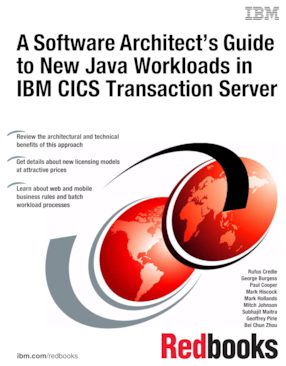A Software Architect's Guide to New Java Workloads in IBM CICS Transaction Server
An IBM Redbooks publication
Note: This is publication is now archived. For reference only.

Published on 22 December 2014, updated 21 January 2015
ISBN-10: 0738440256
ISBN-13: 9780738440255
IBM Form #: SG24-8225-00
Authors: Rufus Credle, George Burgess, Paul Cooper, Mark Hiscock, Mark Hollands, Mitch Johnson, Subhajit Maitra, Geoffrey Pirie and Bei Chun Zhou
This IBM® Redpaper Redbooks® publication introduces the IBM System z® New Application License Charges (zNALC) pricing structure and provides examples of zNALC workload scenarios. It describes the products that can be run on a zNALC logical partition (LPAR), reasons to consider such an implementation, and covers the following topics:
This book also covers what is commonly referred to as plain old Java objects (POJOs). The Java virtual machine (JVM) server is a full-fledged JVM that includes support for Open Service Gateway initiative (OSGi) bundles. It can be used to host open source Java frameworks and does just about anything you want to do with Java on the mainframe. POJO applications can also qualify for deployment using the Value Unit Edition. Read about how to configure and deploy them in this companion Redbooks publication:
IBM CICS and the JVM server: Developing and Deploying Java Applications, SG24-8038
Examples of POJOs are terminal-initiated transactions, CICS web support, web services, requests received via IP CICS sockets, and messages coming in via IBM WebSphere MQ messaging software.
Part 1. New workloads on the mainframe
Chapter 1. Mainframe workload pricing
Part 2. Liberty profile and CICS
Chapter 2. Introduction to the Liberty JVM server
Chapter 3. Using CICS Liberty JVM servers to develop application interfaces
Chapter 4. Porting JEE applications to a CICS Liberty JVM server
Part 3. Mobile devices
Chapter 5. Connecting mobile devices to CICS Transaction Server
Chapter 6. Mobile devices and CICS Liberty JVM server
Chapter 7. Mobile devices and CICS TS Java
Part 4. IBM Operational Decision Manager
Chapter 8. Decision management integrated in IBM CICS Transaction Server
Chapter 9. Implementing decision management in CICS TS
Part 5. Modern Batch feature
Chapter 10. Modern batch workloads
Chapter 11. Modern batch use scenario